2017 - 2018
| Team Photo |
Team Members |
Description |
 |
Adam Del Rosso, Evan Cody Endeman, Aleksandar Kaludjerovic, Christopher Kelly Winch |
The Unicycle Training Device (UTD) aims to soften the difficult learning curve of the unicycle without acting as a crutch to be relied upon. This allows the rider to slowly become less reliant on the system such that they can eventually ride the unicycle independently. The UTD uses a system of extension springs to maintain the unicycle’s upright position. As the rider’s skill improves, the tension in these springs can be decreased, lessening the stabilizing effect and making the system more similar to a free-standing unicycle. The entire system is attached to a wheeled housing, allowing the rider to operate the unicycle with minimal spatial limitations. Faculty Supervisor: Paul Kurowski Lab Supervisor: Adam Woodhouse |
| Team Photo |
Team Members |
Description |
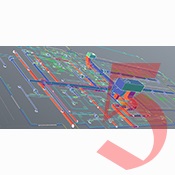 |
Siran Jia, Ze Ming Zhong |
A HVAC system is in demand due to a local owner has planned to build a new Meteorological Station for the purpose of additional monitoring of weather located in the Diego Ramirez Islands (Islas Diego Ramirez), Chile. Diego Ramirez Islands are located in a remote location with only limited accessible resources and utilities, so a solution for the resource shortage is in need. The harsh tundra climate will also become a challenge for the project. The facility is a 24 hour a day, seven days a week operation that is self-sustaining in all department. HVAC system is the essential part for a building and accuracy of load calculations is crucial for us to design a successful HVAC system. The team is going to calculate the load of each zone of the building based on the ASHRAE Standards. Furthermore, the team will design the entire HVAC system and select equipment for this building based on the customer’s requirements and ASHRAE standards. Life cycle cost analysis will be made to select the most cost-effective equipment. Building life cycle must be long enough to sustain a desirable time period (50 years). Faculty Supervisor: Chris Degroot Lab Supervisor: Walid Altahan |
| Team Photo |
Team Members |
Description |
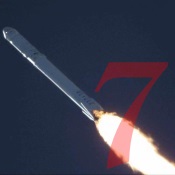 |
Peter Thomas Nielsen, Joseph Shumka Santarelli, Ahmed Madi Tanashi |
The project is to build a heat exchanger to expand a cryogenic fluid and use the expanded gas to pressurize rocket fuel tanks. The pressurized fuel can then be pushed into a combustion chamber and out of the rocket to generate thrust without the need of an expensive and complex turbopump. The cryogenic fluid will need to be heated at a specified temperature, at a given flow rate that is dependant on the requirements of the launch vehicle. This style of rocket engine has been used in the past for engines such as the SpaceX Kestrel engine, and the acent/ decent engines on the lunar lander. The main benefit of this style of engine is its simplicity, due to the removeal of the complex turbopumps used of other engines. Cryogenic heat exchanges are also used for other applications, such as hydro carbon processing, and air separation. The goal of this project is to design an build a prototype cryogenic heat exchanger, to provide data on the behavior of the fluids in our application. This will provide the knowledge required to build on this initial prototype, and design a heat exchanger specific for the launch vehicle. Faculty Supervisor: Chris Degroot Lab Supervisor: Walid Altahan |
| Team Photo |
Team Members |
Description |
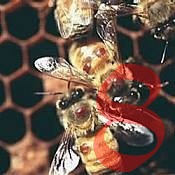 |
Corrine Dawson, Francisco Jose Diaz, Yongfan Ke, Kyle Steven Teather |
This project focused on designing a device which aids beekeeping hobbyists eliminate varroa mite infestations in their hives and prevent colonial collapse. It was to be more effective and less expensive than the standard chemical treatments or newer nonchemical electric ones. A module was developed to sit between the hives’ supers and treat the hives with heated air by pushing the air into the hive frames to keep the temperature in range so as to eliminate the mites without harming the bees. Faculty Supervisor: Chris Degroot Lab Supervisor: Walid Altahan |
| Team Photo |
Team Members |
Description |
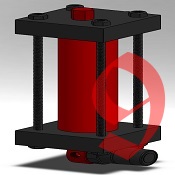 |
Jonathan George Adams, Alexander Jonathon Kalopsis, Johnathan Stacey, Luisa Maria Valencia Vega |
The goal of this project was to explore the nuanced process of brewing espresso and to develop a portable device that would allow users to easily make espresso consistent in quality to that produced at a coffee shop or with a home espresso machine. Our device uses compressed air to pressurize enough water for two shots of espresso to the generally-accepted brewing pressure of 9 bar. Faculty Supervisor: Chris Degroot Lab Supervisor: Walid Altahan |
| Team Photo |
Team Members |
Description |
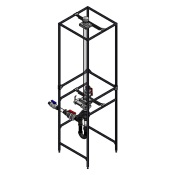 |
Kyle Graat, Brooke Danen Remler, Darren C Kit Wong |
Developing a comprehensive research apparatus for Trojan Technologies to explore different measurement techniques for measuring the head of the wastewater as it pass through a filter sample. The goal of the project is to determine new methods that can accurately acquire results regarding the effective permeability and removal efficiency of the filter. Determination of effective methods can propel the development of testing equipment that can be shipped world wide with sales associates for specifying the number of filtration units required by a particular customer. Faculty Supervisor: Chris Degroot Lab Supervisor: Walid Altahan |
| Team Photo |
Team Members |
Description |
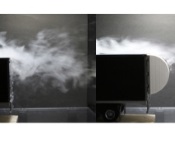 |
Alexandre Galley, Graham Robert Loney, Seth Alexander Marriott, Peter Cameron Serles |
Tractor trailers are a critical component of our modern society. Transportation of consumer and industrial goods has played an integral role in the development and prosperity of our modern world, providing many of the privileges we may now come to take for granted. Whether it be the daily transport of fresh produce or the large shipments of industrial goods, ground transportation plays a critical role in our daily lives. With rising fuel costs, the need for drag-reducing technology has significantly increased. There have been emerging technological improvements in the aerodynamic equipment used in the transportation industry. Truck skirts, wheel disk covers, and rear-trailer fairings are becoming more common on the freeway. Trucking fleets are investing in these devices as they find that they benefit both fuel costs and corporate image. The engineering problem at hand is to design a rear truck fairing concept to offer a tangible reduction in trucking fuel consumption. An operating system is to activate a conceptualized fairing design through a selected method of actuation. The fairing concept will reduce drag forces and increase streamlining effects on the vehicle, with the primary objective being reduction of fuel consumption. Faculty Supervisor: Chris Degroot Lab Supervisor: Walid Altahan |
| Team Photo |
Team Members |
Description |
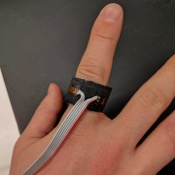 |
David Timothy Axford, Calvin Thomas Roy Delancey, Glenn Robert Kernaghan, Francis Marlon Lozada |
The Finger Touch Force Measurement Sensor is a non-intrusive device to measure tactile force in the middle and proximal phalanges. This device is unique in that it is attached to the dorsal side of the hand to prevent obstruction of the tactile sensitive skin on the palm side of the hand. Faculty Supervisor: Louis Ferreira Lab Supervisor: Dave Lunn |
| Team Photo |
Team Members |
Description |
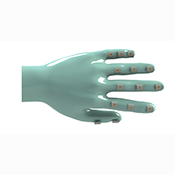 |
Samuel Quincy Bertling, Matthew Clenchy, Stephen Ochotta, Gregory Francis Simioni |
The force-sensing surgical glove is designed to provide quantifiable feedback during medical procedures/training to provide a reference point in regards to the forces required to achieve a desired result. The force-sensing surgical glove prototype is instrumented with strain gauges, which quantify the deformation of the users finger into a force measurement. The aim is to integrate the measurement system into a glove apparatus which can easily and effectively be used for finger force measurement during medical (and other fields) training. Faculty Supervisor: Louis Ferreira Lab Supervisor: Dave Lunn |
| Team Photo |
Team Members |
Description |
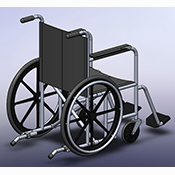 |
Alexandre Laurent Caskanette, Adam Peter Hoehne, Timothy James Moore, Jonathan Peter Noszenko |
The majority of commercially available anti-tipping wheelchair supports require an assistant to be present and physically adjust the position of the supports. This is an issue because it can diminish the user’s independence when navigating challenging terrain. Our design aims to eliminate this problem by granting the wheelchair user the ability to easily adjust the position of their anti-tipping supports. Faculty Supervisor: Louis Ferreira Lab Supervisor: Adam Woodhouse |
| Team Photo |
Team Members |
Description |
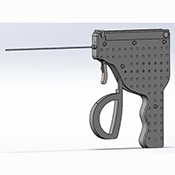 |
Aahmed Saeed Bhatti, Sara Frances Holland, Victoria Ann Kerr, Kortney Ann Watson |
The device shown below is used to insert small diameter radiograph tracking beads into the anterior cruciate ligament (ACL) of the knee during arthroscopic surgery. These beads allow for more clear and precise images of the biological soft tissue, providing researchers with a better understanding of the effects of physiological loading on the ACL. The device improves on current bead insertion procedures by utilizing a cartridge system to preload beads, allowing for multiple insertions at once. Faculty Supervisor: Louis Ferreira Lab Supervisor: |
| Team Photo |
Team Members |
Description |
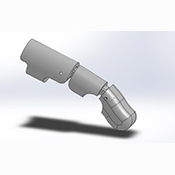 |
Josh Charles Foy, Maxim Miceta, Nathan Kevin Wang, Geofrey George Yamomo |
This bionic prosthetic finger prototype was designed to replace finger amputations, due to accidents or diseases, located between the MCP and PIP joints. The prototype is fabricated through 3D printing processes to achieve a lightweight and affordable product. Flexion and extension of the finger will be controlled via sEMG signals. Faculty Supervisor: Louis Ferreira, George Knopf Lab Supervisor: Dave Lunn |
| Team Photo |
Team Members |
Description |
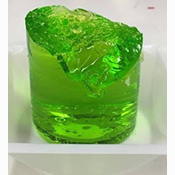 |
Malcolm Cameron Mcwilliam, Amin Mukhlis, Darius Antanas Romanowski, Kyle Robert Wilson |
Electroactive polymers are materials that exhibit deflections when subjected to an electric field. This project has achieved macroscopic deflections using sample sizes considerably larger than those seen in previous studies. This project focuses on optimizing the production of electroactive gel polymers, and presents several empirical relationships that detail its performance characteristics. Faculty Supervisor: Louis Ferreira, George Knopf Lab Supervisor: Dave Lunn |
| Team Photo |
Team Members |
Description |
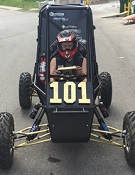 |
Joseph Carmelo Fotia, Taylor William Hammond, Philippe Laberge, Ryan Andrew Willnecker |
Western University’s Baja SAE Team has been participating in annual events for several years. In the pursuit for constant improvement, a need exists to reduce the turning radius from 12’ to 9’ without changing the overall dimensions of the vehicle. Our team has designed a four wheel steering system that will allow the front and rear wheel turn in opposite directions resulting in a smaller turning radius. The front wheels will be steered using the traditional mechanical method, while an electric actuator and bell crank will provide motion to the rear wheels. Faculty Supervisor: Paul Kurowski Lab Supervisor: Dave Lunn |
| Team Photo |
Team Members |
Description |
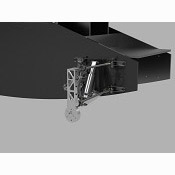 |
Joseph Michael Simic, Sajjan Singh, Daniel Woodside, Wei An Yang |
The SunStang Solar car is the University of Western Ontario’s only solar powered vehicle. A regulation change to mandate all cars to have four wheels was the driving force in this design. The design of a new, multilink, rear suspension system helped to implement the change from a three wheeled vehicle to four. This competitive design will be hitting the raceway this summer at the American Solar Car Challenge. If you’re into cars, or unique and interesting designs, come check us out! Faculty Supervisor: Paul Kurowski Lab Supervisor: Mesfin Gebreyes |
| Team Photo |
Team Members |
Description |
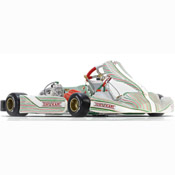 |
Michael Hogg, Devan Theander |
A stiffness testing fixture for the rear axle assembly of a high performance racing kart. This test fixture will be used to test current kart components and develop new components for this assembly, specifically focusing on the stiffness of these components and the effect on the kart’s vehicle dynamics and handling characteristics. Faculty Supervisor: Paul Kurowski Lab Supervisor: Mesfin Gebreyes |
| Team Photo |
Team Members |
Description |
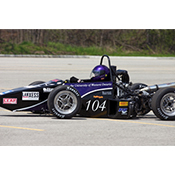 |
Miguel Achtymichuk, Bennet Christopher William Heidenreich, Devin Luke Hulshof, Christopher Michael Kornas |
A common problem faced in racing is that many external factors, ranging from track temperature to tire wear, can affect the handling of the vehicle, or more specifically the under-steer/ over-steer characteristics of the car. Under-steer can be defined as less yaw acceleration than desired by the driver at a given moment in time. Conversely, over-steer can be defined as excess yaw acceleration compared to what is desired by a driver at the given moment. Over-steer or under-steer can have adverse effects on the lap time of a racecar. This is most notable in extreme cases where over-steer can lead to a car "spinning out" and under-steer can lead to a car "pushing through" or missing a turn due to under rotation. However even in less severe cases over/under steer can still reduce lap times by forcing a driver to reduce their speed to maintain control of the vehicle. The many external factors that can affect the car’s handling performance act in a chaotic manner which means as a race engineer it can be close to impossible to predict if a vehicle will have over or understeer issues next time they come to the pit. It is therefore desirable for it to be possible for a race team to change the cars handling during a race if required. For this reason, the problem definition of this project is to "Design a system that would allow for a race team to tune the handling (over-steer or under-steer) characteristics of a race car." Faculty Supervisor: Paul Kurowski Lab Supervisor: Mesfin Gebreyes |
| Team Photo |
Team Members |
Description |
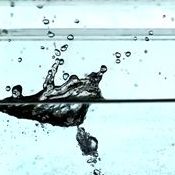 |
Luca Breda, Noah Dibley, Philip Protomanni, Jacob Harrison Sokoloff |
An anti-splash pad is being developed for urinals to mitigate the splash effect created by urine hitting a urinal. To improve hygiene for all, the team has closely studied fluid dynamics and flow dampening techniques. Faculty Supervisor: Chris Degroot Lab Supervisor: Adam Woodhouse |
| Team Photo |
Team Members |
Description |
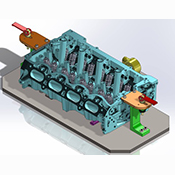 |
Juliusz Piotr Gasior, Adonay Gebremariam, Akeem Hinds, Michael Kozlowski |
This shaker unit was designed to reliably remove cotter pins from intake and exhaust ports from an engine head that underwent repair. The components in the prototype will be fabricated from AISI 1060 steel to provide high specific stiffness at a low material cost. Faculty Supervisor: Louis Ferreira Lab Supervisor: |
| Team Photo |
Team Members |
Description |
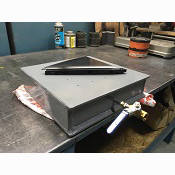 |
Robert James Gray, Mark William Major, Joel Reed, Braden Darrell Scott |
The objective of this project is to design a thermoforming table for Sle-Co (a Tier II automotive plastic parts supplier for OEM markets) to apply Wavelock Applique film on selected parts. The film is mainly for aesthetic appeal but also protects the part from scratching and damage. A Vacuum pressure delivery system was created to draw the heated Wavelock film over a part to form the desired film shape. The formed shape is then applied to a Sle-Co part by an existing injection moulding process. Faculty Supervisor: Chris Degroot Lab Supervisor: Mesfin Gebreyes |
Laboratory Supervisors
Walid Altahn, waltahan@uwo.ca
Mesfin Gebreyes, mgebreye@uwo.ca
Dave Lunn, dalunn@uwo.ca
Adam Woodhouse, awoodhou@uwo.ca





















